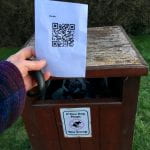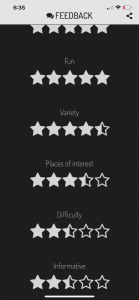When the MJM20 course leaders designed this course, and posed questions for Week 9’s drone topic such as “Have you seen video footage from a drone? Why are drones so popular as present?” (Sourbati, 2019) it is unlikely that the use of drones to fight Covid-19 was anticipated. Drones have recently been used by police forces in a number of countries to enforce the new social distancing and isolation rules.
My case study for this week is Derbyshire Police’s (2020) Twitter post which included an annotated drone footage of unwanted visitors to the Peak District, during a public health lockdown period (see figure 1). This Twitter post was widely reported by news media (eg BBC, 2020; Pidd and Dodd, 2020; ITV, 2020). The remote location of the Peak District should be noted in this case because while surveillance cameras are standard fixtures in urban spaces, they have not previously been associated with the open countryside. A point for consideration is whether the drone, as used by Derbyshire Police, extended the boundaries of the digital city.
Figure 1: @DerbysPolice Twitter post, 26 March 2020 [screenshot taken 28 March 2020]
https://twitter.com/DerbysPolice/status/1243168931503882241?s=20
Jensen (2016:71-72) proposes that there are six dimensions of surveillance, two of which are illustrated in this case study. Jensen’s first dimension is “Copresent humans” where humans watch humans, with the example given being police officers watching citizens. In the Derbyshire Police example, the drone is operated by police officers and the citizens being filmed by the drone would probably have been aware of a drone flying near them. However the viewing position would not have been “from the same vertical position”, as the drone footage clearly shows the camera angle looking down on the people and their cars. The position of the drone above the people is a position of power for the drone.
Jensen’s (2016:72) fifth dimension “Drone surveillance” highlights that drones “represent a mobile tracking and surveillance scenario, creating a very versatile and situational flexible surveillance system”. As noted above, this versatility extended the reach of police activity outside of what might have been considered the boundaries of the city. In his conclusion, Jensen (2016:73) poses some pertinent questions:
“What happens with our cities if the fifth dimension of surveillance becomes institutionalised as a standard operation procedure of surveillance? Seen from the point of view of the state apparatus, this means new and unseen potential for crowd control and surveillance. Seen from the point of view of the citizen, this means the end of public space as we know it.”
The question that I think was missing in Jensen’s paper was about the use of the drone surveillance footage after it was captured. Jensen focuses on the scene when the drone is operated, but as demonstrated by the Derbyshire Police Twitter post, the sharing and resharing of the annotated video succeeded in reaching a much wider audience and challenged the notion of public spaces and the perceived freedoms in such spaces.
References
BBC (2020). Coronavirus: Peak District drone police criticised for ‘lockdown shaming’. BBC, 27 March. Retrieved from https://www.bbc.co.uk/news/uk-england-derbyshire-52055201
Derbyshire Police (2020) @DerbysPolice Twitter post 26 March. Retrieved from: https://twitter.com/DerbysPolice/status/1243168931503882241?s=20 [accessed 28 March 2020]
ITV (2020). Derbyshire Police post video shaming people for breaching lockdown rules. ITV, 26 March. Retrieved from https://www.itv.com/news/calendar/2020-03-26/derbyshire-police-post-video-shaming-people-for-breaching-lockdown-rules/
Jensen, O.B., (2016) Drone city – power, design and aerial mobility in the age of “smart cities.” Geographica Helvetica, 71(67–75), pp.66–75, Denmark
Pidd, H. and Dodd, V. (2020). UK police use drones and roadblocks to enforce lockdown. Guardian, 26 March. Retrieved from https://www.theguardian.com/world/2020/mar/26/uk-police-use-drones-and-roadblocks-to-enforce-lockdown
Sourbati, M. (2019). ‘MJM20 Digital Cities Module Handbook – 2019/20’, University of Brighton School of Media, Brighton



















